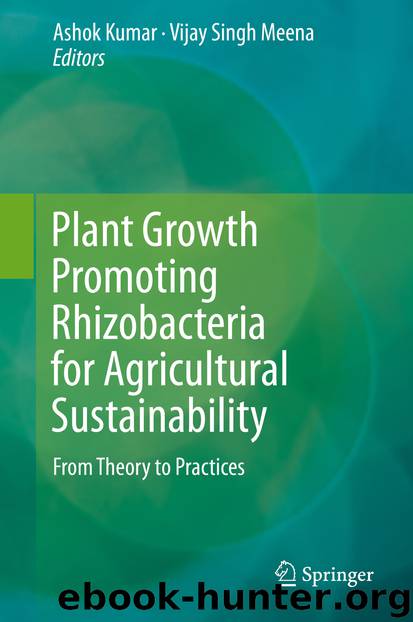Plant Growth Promoting Rhizobacteria for Agricultural Sustainability by Ashok Kumar & Vijay Singh Meena

Author:Ashok Kumar & Vijay Singh Meena
Language: eng
Format: epub
ISBN: 9789811375538
Publisher: Springer Singapore
8.2 PGPR in Plant Disease Management
PGPRs are the distinct group of microbes that suppress the deleterious pathogens in crop plants. The genera normally used as biocontrol agents are Agrobacterium, Bacillus, Burkholderia, Pseudomonas, Streptomyces, etc. Among the diversity of PGPR, Pseudomonas and Bacillus spp. have a wide distribution and are the extensively studied genera for PGPR as a biocontrol. In particular, the soilborne fluorescent pseudomonads have received particular interest due to its excellent root-colonizing abilities and their capacity to produce a wide range of antifungal metabolites (Olivain et al. 2004). These organisms combat the plant disease by competition, enzymatic lysis, production of antibiotics, hydrogen cyanide, siderophores, induced systemic resistance (ISR), or any other mechanisms. The rhizosphere soil is an active site with complex interactions between the root and the associated PGPR (Sylvia et al. 1998). At this point, the PGPR enhances plant growth and development by direct and/or indirect mechanisms. Direct mechanisms elicit growth promotion by biological nitrogen fixation (BNF), production of hormones such as indole-3-acetic acid (IAA), gibberellic acid (GA3), cytokinin and phosphate, potassium and zinc solubilization or mobilization (Idris et al. 2008), production of siderophores for sequestering of iron (Fe) from the soil and supply it to the plants and synthesis of hydrogen cyanide, etc. (Keel and Defago 1997). Some strains improve the innate ability to tolerate the stresses like acidity, salinity, drought, etc., besides production of 1-aminocyclopropane-1-carboxylate (ACC) deaminase enzyme to lower the ethylene synthesis and synthesis of fungal cell wall lytic enzymes.
Secondly, indirect mechanisms include suppression of harmful/deleterious rhizosphere microbes through induced systemic resistance (ISR), which are normally recognized as having a role in biocontrol (Dobbelaere et al. 2003). Induced systemic resistance is based on the activation of plant defense mechanisms by rhizobacterial strains and is considered natural, eco-friendly, and safe besides providing resistance against a broad spectrum of pathogens (Sticher et al. 1997). The rhizobacteria need to colonize the roots to a sufficient level for induction of resistance in the host. For example, in radish, a minimal number of 105 colony-forming units (cfu) per g root of bacteria is required to induce resistance in the host (Raaijmakers et al. 1995). Colonization of plants by biocontrol agents induces cell wall modifications, viz., deposition of callose, pectin, cellulose, and phenolic compounds leading to the formation of a structural barrier at the site of potential attack by phytopathogens (Benhamou et al. 2000). Defense reaction occurs due to accumulation of PR proteins (chitinase, β-1,3-glucanase), phenylalanine ammonia lyase, peroxidase, phenolics, callose, lignin, and phytoalexins (Harish et al. 2009b).
The successful establishment of an introduced PGPR depends on its compatibility/establishment with the crop and also on its interaction with indigenous microflora. An ideal PGPR should be rhizosphere competent, enhance plant growth, be easy to mass multiply, possess broad spectrum of action, have consistent biological control activity, be safe to the environment, and be compatible with other rhizobacteria (Nakkeeran et al. 2005; Barea, 2015). Therefore, identification of a functional PGPR strain possessing the growth-promoting and broad-spectrum biocontrol activity is an ever-challenging one. Utilization of
Download
This site does not store any files on its server. We only index and link to content provided by other sites. Please contact the content providers to delete copyright contents if any and email us, we'll remove relevant links or contents immediately.
International Integration of the Brazilian Economy by Elias C. Grivoyannis(91660)
The Radium Girls by Kate Moore(11930)
Turbulence by E. J. Noyes(7942)
Nudge - Improving Decisions about Health, Wealth, and Happiness by Thaler Sunstein(7622)
The Black Swan by Nassim Nicholas Taleb(7016)
Rich Dad Poor Dad by Robert T. Kiyosaki(6413)
Pioneering Portfolio Management by David F. Swensen(6229)
Man-made Catastrophes and Risk Information Concealment by Dmitry Chernov & Didier Sornette(5925)
Zero to One by Peter Thiel(5691)
Secrecy World by Jake Bernstein(4652)
Millionaire: The Philanderer, Gambler, and Duelist Who Invented Modern Finance by Janet Gleeson(4385)
The Age of Surveillance Capitalism by Shoshana Zuboff(4216)
Skin in the Game by Nassim Nicholas Taleb(4165)
Bullshit Jobs by David Graeber(4101)
The Money Culture by Michael Lewis(4082)
Skin in the Game: Hidden Asymmetries in Daily Life by Nassim Nicholas Taleb(3935)
The Dhandho Investor by Mohnish Pabrai(3705)
The Wisdom of Finance by Mihir Desai(3658)
Blockchain Basics by Daniel Drescher(3511)
